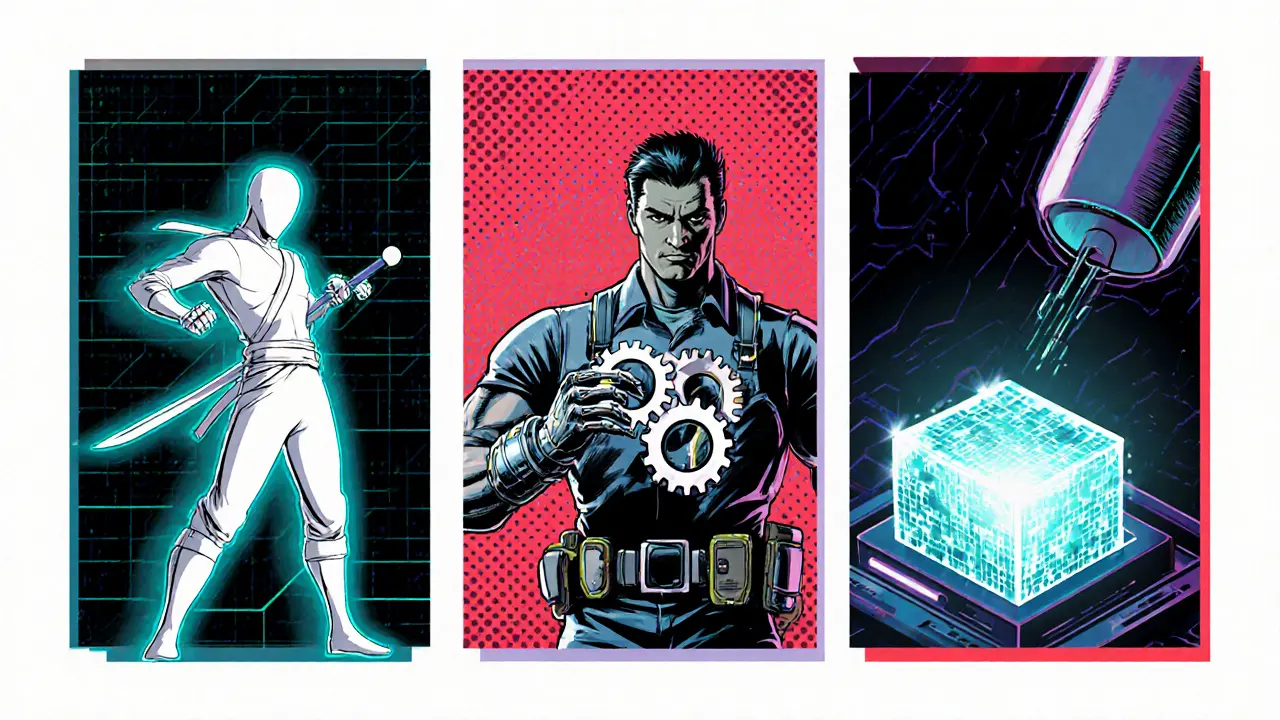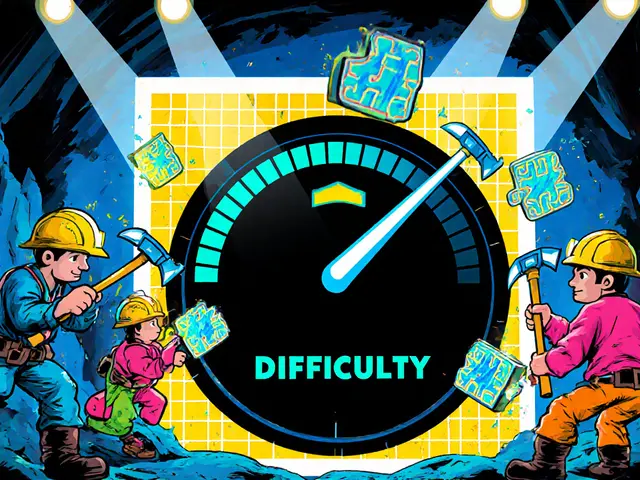Blockchain Signature Algorithm Selector
Select your project requirements below to find the optimal digital signature algorithm for your blockchain application.
Recommended Algorithm:
Select your requirements and click "Analyze My Requirements" to get a recommendation.
Algorithm Comparison
| Algorithm | Security Maturity | Key Size (bits) | Signature Size (bytes) | Deterministic? | Aggregation Support |
|---|---|---|---|---|---|
| ECDSA | Battle-tested (since 2009) | 256 (secp256k1) | ~70-72 | No (requires fresh RNG) | No native aggregation |
| EdDSA | Newer but widely vetted (Curve25519) | 256 (Curve25519) | ~64 | Yes (deterministic) | Limited (no native aggregation) |
| Schnorr | Provably secure, rolling out in Bitcoin | 256 (secp256k1) | ~64 | Yes (deterministic nonces) | Yes (signature aggregation) |
| BLS | Emerging, used in some PoS chains | 256-384 (BLS12-381) | ~48-64 (aggregated) | Yes | Yes (block-level aggregation) |
Quick Take
- ECDSA powers Bitcoin and most major crypto networks, balancing security and small key sizes.
- EdDSA uses deterministic signing and resists many random‑number attacks, popular in privacy‑focused chains.
- Schnorr signatures add aggregation, making multi‑input transactions leaner and more private.
- BLS signatures push aggregation further, enabling block‑level signature compression.
When you hear the term digital signature algorithms in the context of blockchain, you’re really hearing about the math that lets a transaction prove it came from the right owner without anyone else being able to forge it. In this guide we’ll break down the four algorithms that dominate the space, see how they differ, and figure out which one fits which use case.
Why Signatures Matter in a Trust‑less Ledger
Every block on a public ledger contains dozens, sometimes thousands, of transactions. Each transaction must answer two questions:
- Did the sender really own the funds?
- Has the data been tampered with after it was signed?
Both answers come from a cryptographic signature. The signature is mathematically linked to the sender’s private key and the transaction data, yet anyone can verify it with the public key. No central authority is needed, and the network can stop replay attacks instantly.
Core Algorithms and Their Building Blocks
The blockchain ecosystem mainly relies on four families of signature schemes. Below each one is introduced with a ECDSA Elliptic Curve Digital Signature Algorithm, the original workhorse behind Bitcoin’s security. It runs on the secp256k1 a 256‑bit elliptic curve specially chosen for Bitcoin and many other coins.
Next up is EdDSA Edwards‑curve Digital Signature Algorithm that uses the twisted curve Curve25519. The curve Curve25519 a high‑performance elliptic curve designed for fast, secure key exchange and signatures gives EdDSA its deterministic edge.
The third family, Schnorr signatures a simple yet powerful scheme that enables signature aggregation, builds on the same curve math as ECDSA but adds linearity.
Finally, BLS signatures Boneh‑Lynn‑Shacham signatures that rely on pairing‑based cryptography for compact aggregation are gaining attention for block‑wide compression.
How Each Algorithm Works - A High‑Level Walkthrough
ECDSA (Elliptic Curve Digital Signature Algorithm)
- Key generation: pick a random integer d in [1,n‑1] and compute the public key Q = d·G, where G is the curve’s base point.
- Signing: generate a per‑message secret k, compute a point (x₁,y₁) = k·G, then derive the pair (r,s) = (x₁ mod n, (hash+r·d)/k mod n).
- Verification: using the sender’s public key Q, recompute a point and check that the derived r matches the one in the signature.
Bitcoin, Ethereum, Binance Smart Chain, and Avalanche all rely on this flow.
EdDSA (Edwards‑curve Digital Signature Algorithm)
- Key generation: similar to ECDSA but based on the twisted Edwards curve; the private scalar is a hash of a seed, ensuring determinism.
- Signing: no random k is generated. Instead, a nonce is derived deterministically from the private key and message hash, eliminating a whole class of RNG‑related bugs.
- Verification: a single elliptic‑curve point multiplication checks the signature against the public key.
Monero, Stellar, and Nano have adopted EdDSA for its speed and built‑in resistance to certain side‑channel attacks.
Schnorr Signatures
- Key generation: identical to ECDSA (private key d, public key Q = d·G).
- Signing: compute a deterministic nonce r, then produce a signature (e,s) where e = H(r·G || message). The final s = r + e·d (mod n).
- Verification: confirm that s·G = r·G + e·Q, which is a simple linear equation.
The linear equation lets you add multiple signatures together-perfect for multi‑input Bitcoin transactions.
BLS Signatures
- Key generation: pick a secret x and compute the public key X = g^x on a pairing‑friendly curve (e.g., BLS12‑381).
- Signing: compute sigma = H(message)^x.
- Verification: check that e(sigma,g) = e(H(message),X) using a bilinear pairing e.
Because the pairing operation is linear, you can aggregate signatures from many users into a single sigma, shaving off roughly half the size compared to ECDSA.
Side‑by‑Side Comparison
| Algorithm | Security maturity | Key size (bits) | Signature size (bytes) | Deterministic? | Aggregation support | Typical blockchains |
|---|---|---|---|---|---|---|
| ECDSA | Battle‑tested (since 2009) | 256 (secp256k1) | ~70‑72 | No (requires fresh RNG) | No native aggregation | Bitcoin, Ethereum, BSC, Avalanche |
| EdDSA | Newer but widely vetted (Curve25519) | 256 (Curve25519) | ~64 | Yes (deterministic) | Limited (no native aggregation) | Monero, Stellar, Nano |
| Schnorr | Provably secure, rolling out in Bitcoin | 256 (secp256k1) | ~64 | Yes (deterministic nonces) | Yes (signature aggregation) | Bitcoin (taproot upgrade), future Bitcoin forks |
| BLS | Emerging, used in some PoS chains | 256‑384 (BLS12‑381) | ~48‑64 (aggregated) | Yes | Yes (block‑level aggregation) | Ethereum 2.0 (validator attestations), Dfinity |

Choosing the Right Algorithm for Your Project
Imagine you’re building a new layer‑2 scaling solution. If you need ultra‑fast verification of thousands of tiny payments, Schnorr’s batch verification shines. For a privacy‑focused coin where deterministic signing reduces attack surface, EdDSA is a natural fit. When you’re targeting maximum compatibility with existing wallets and exchanges, ECDSA wins out despite its larger signatures.
Here’s a quick decision tree you can follow:
- Do you need signature aggregation across many inputs? → Choose Schnorr or BLS.
- Is deterministic signing a hard requirement for compliance or security audits? → Pick EdDSA.
- Do you rely on legacy tooling and need the broadest ecosystem support? → Stick with ECDSA.
- Are you designing a proof‑of‑stake validator set where block‑level aggregation saves bandwidth? → BLS is worth the extra pairing cost.
Real‑World Experiences from the Field
Bitcoin developers spent years debating a soft‑fork to enable Schnorr. The payoff? Smaller transaction blobs, hidden multi‑sig data, and less fee pressure. Ethereum’s roadmap still lists ECDSA as the default, but research teams are prototyping post‑quantum EdDSA variants for future upgrades.
Monero’s switch to EdDSA gave it a smoother signature size and eliminated the infamous “nonce reuse” bugs that once plagued older implementations. However, developers note that fewer hardware wallets support EdDSA out of the box, forcing a temporary trade‑off.
XRP’s ledger can verify both ECDSA and EdDSA signatures, showing that a mixed‑algorithm approach is feasible when you need to transition slowly.
Future Trends: Post‑Quantum and Beyond
Quantum computers could break the discrete‑log problem that underpins all four schemes. The NIST post‑quantum standardization process is already highlighting Falcon, Dilithium, and Rainbow as candidates for future blockchain use. Early pilots on testnets are experimenting with Dilithium‑based signatures, but we’re still several years out before a major network can safely migrate.
On the aggregation front, researchers are tightening the performance gap between Schnorr and BLS. A hybrid model-Schnorr for user‑level signatures and BLS for block attestations-might become the norm in proof‑of‑stake systems.
Practical Tips and Pitfalls to Avoid
- Never reuse nonces. In ECDSA, a reused k value can leak the private key. Use a cryptographically secure RNG or switch to a deterministic scheme.
- Validate library implementations. Not all open‑source crypto crates follow the latest side‑channel mitigations. Check audit reports before integrating.
- Plan for upgrades. If you start with ECDSA, design your transaction format to allow a future flag for Schnorr or BLS without breaking backward compatibility.
- Test aggregation logic early. Batch verification can expose timing side‑channels; simulate worst‑case loads on testnets first.
Key Takeaways
Digital signature algorithms are the silent workhorses that keep blockchains trustworthy. ECDSA dominates today because it’s mature and widely supported. EdDSA offers deterministic safety and speed for newer projects. Schnorr brings aggregation and smaller transactions, and BLS pushes aggregation to the block level. The right choice hinges on your performance needs, security posture, and ecosystem constraints. Keep an eye on post‑quantum research-your next major upgrade may involve swapping out these algorithms entirely.
Frequently Asked Questions
What makes ECDSA still the most popular signature algorithm?
ECDSA has been part of Bitcoin since 2009, so it benefits from a huge amount of real‑world testing, mature libraries, and wallet support. Its 256‑bit key size offers strong security while keeping data small enough for blockchain storage.
Why is deterministic signing important?
Deterministic signing removes the need for a fresh random number each time you sign. That eliminates a whole class of exploits where a weak RNG leaks private keys, which is a known vulnerability in many ECDSA implementations.
Can I mix different signature algorithms in the same blockchain?
Yes. XRP shows that a ledger can verify both ECDSA and EdDSA signatures. The trade‑off is added verification code and the need for nodes to carry multiple crypto libraries.
What is signature aggregation and why does it matter?
Aggregation combines several signatures into one, shrinking transaction size and cutting verification time. Schnorr and BLS support this, which helps scaling solutions and reduces fees for users.
Are there quantum‑ready alternatives today?
Post‑quantum candidates like Falcon and Dilithium are being trialed on testnets, but no major public chain has fully switched yet. Expect a gradual migration over the next decade.




Brooklyn O'Neill
December 14, 2024 AT 13:19Great overview! The way you broke down each algorithm’s pros and cons makes it easy to pick the right one for a new project. I especially appreciate the practical tip about never reusing nonces – that’s a classic pitfall for newcomers.
Patrick MANCLIÈRE
December 16, 2024 AT 20:52This guide is a solid bridge between theory and practice. For anyone handling cross‑chain bridges, noting that BLS can compress validator attestations while still keeping security high is a game‑changer. It also clears up a lot of confusion around deterministic signing versus traditional RNG‑based signatures.
Ciaran Byrne
December 19, 2024 AT 04:26Never reuse ECDSA nonces.
Carthach Ó Maonaigh
December 21, 2024 AT 11:59Yo, if you’re still stuck on ECDSA and don’t wanna deal with BLS’s pairing math, just remember: you’re paying extra fees for every extra byte you waste on a non‑aggregated signature. Upgrade or keep bleeding cash.
Marie-Pier Horth
December 23, 2024 AT 19:32Ah, the symphony of cryptography! One can almost hear the digital quills dancing across the blockchain parchment, each signature a lyrical stanza in the grand epic of decentralised trust.
Gregg Woodhouse
December 26, 2024 AT 03:06meh, looks fine. could use more pics tho.
F Yong
December 28, 2024 AT 10:39Oh, the joys of deterministic signing – because who doesn’t love a system that guarantees you’ll never accidentally hand over your private key to a faulty RNG? Sarcasm aside, it’s a solid security win.
Sara Jane Breault
December 30, 2024 AT 18:12Nice breakdown! If you’re just starting out, try EdDSA for its simplicity and speed, then graduate to Schnorr or BLS when you need aggregation. The transition is smoother than you think.
bhavin thakkar
January 2, 2025 AT 01:46When you dive into digital signature algorithms, the first thing to understand is the underlying problem they solve: proving ownership without revealing the secret.
ECDSA, the workhorse behind Bitcoin, relies on a random per‑message nonce. If that nonce ever repeats, the private key can be recovered – a disastrous scenario that plagued early implementations. That’s why deterministic schemes like EdDSA are appealing: they derive the nonce from the private key and message hash, eliminating the RNG weakness entirely.
Moving to EdDSA, you get a 64‑byte signature with built‑in resistance to side‑channel attacks, thanks to the Edwards curve arithmetic. It also speeds up verification because it avoids the extra modular inversion step needed in ECDSA.
Schnorr signatures, on the other hand, bring linearity to the table. Because the signing equation is linear, you can aggregate multiple signatures into a single one, dramatically reducing transaction size. This is why Bitcoin’s Taproot upgrade is so exciting – it enables multi‑signature privacy and efficiency without changing the underlying script language.
BLS pushes aggregation further. Using pairings on the BLS12‑381 curve, you can compress hundreds of validator attestations into a single 48‑byte signature. The trade‑off is heavier computational cost during verification, but for proof‑of‑stake chains where block‑level aggregation matters, it’s worth it.
One practical tip: always design your transaction format with a versioned signature flag. That way you can upgrade from ECDSA to Schnorr or BLS without breaking legacy nodes.
Another tip is to keep an eye on the emerging post‑quantum standards. While current algorithms rely on the hardness of the discrete logarithm problem, future quantum attacks will render them insecure. Testnets are already experimenting with Dilithium‑based signatures, so start thinking about a migration path now.
Finally, remember that libraries matter. Not all implementations mitigate timing attacks equally. Choose well‑audited crates, and run your own fuzz tests before deploying to mainnet. By following these best practices, you’ll avoid the common pitfalls that have haunted many blockchain projects.
Thiago Rafael
January 4, 2025 AT 09:19While the previous comment outlines the technical landscape nicely, I’d like to stress the importance of formal verification when integrating any of these signature schemes. Formal methods can prove that your implementation adheres to the cryptographic specifications, eliminating subtle bugs that manual testing might miss. In high‑value environments, this extra rigor can be the difference between a secure system and a catastrophic breach.
Marie Salcedo
January 6, 2025 AT 16:52Loving the clear tables! Seeing the signature sizes side‑by‑side really drives home why aggregation matters for fee‑sensitive users.
dennis shiner
January 9, 2025 AT 00:26👍 concise and spot on.
Krystine Kruchten
January 11, 2025 AT 07:59Good points about library audits – I’ve seen a few projects get burned by an outdated ECDSA implementation that didn’t clear side‑channel checks. Always check the latest version of libsecp256k1 or ed25519‑ref10.
Mangal Chauhan
January 13, 2025 AT 15:32For enterprises contemplating a move to BLS, consider the operational overhead of pairing‑based cryptography. The verification cost is higher, but the bandwidth savings can offset that in large validator sets. A hybrid approach-using Schnorr for everyday transactions and BLS for epoch‑level attestations-often yields the best performance‑security trade‑off.
Darius Needham
January 15, 2025 AT 23:06Exactly, the hybrid model you mention is already in use on several PoS testnets. It lets developers keep transaction latency low while still benefiting from block‑level compression when the network is under heavy load.
WILMAR MURIEL
January 18, 2025 AT 06:39I want to add a personal anecdote: when we switched our Layer‑2 solution from ECDSA to Schnorr, we saw a 12% reduction in gas costs purely from signature aggregation. The migration required updating our SDK, but the long‑term savings were worth every line of code. Also, make sure your users’ wallets support the new scheme; otherwise you’ll face a frustrating adoption curve.
carol williams
January 20, 2025 AT 14:12While the practical gains are evident, it is crucial to also contemplate the governance implications of adopting a new cryptographic primitive. Stakeholder consensus, audit transparency, and clear deprecation pathways must be established to avoid fracturing the community.
Maggie Ruland
January 22, 2025 AT 21:46Cool stuff, but I guess I’ll stick with what my wallet already knows.
jit salcedo
January 25, 2025 AT 05:19Ever wonder why the mainstream media never mentions the hidden backdoors in certain signature implementations? Some cryptographers claim that subtle parameters can be tweaked to give governments escrow capabilities. If you’re paranoid, stick to open‑source, auditable curves like Curve25519.
Raj Dixit
January 27, 2025 AT 12:52Enough of this tech‑gurus’ mumbo‑jumbo! The real issue is national security – we can’t trust foreign‑made algorithms. Use home‑grown primitives or you’re handing over control to outsiders.
Lisa Strauss
January 29, 2025 AT 20:26Stay optimistic! The community is moving fast, and with more education, everyone can pick the right algorithm for their needs.
Darrin Budzak
February 1, 2025 AT 03:59Nice read. It’s good to see a balanced take without the usual hype.
Enya Van der most
February 3, 2025 AT 11:32Seriously, the aggregation capabilities of BLS are a game‑changer for PoS chains. If you’re building a validator set, the bandwidth savings alone make it worth the extra CPU cycles.
Eugene Myazin
February 5, 2025 AT 19:06Totally agree – I’ve been using Schnorr in my side‑chain project and the reduced transaction size has made a noticeable difference in user fees.
karyn brown
February 8, 2025 AT 02:39Looks solid, but don’t forget to keep an eye on the upcoming post‑quantum drafts – future‑proofing is the only way to stay ahead of the curve.